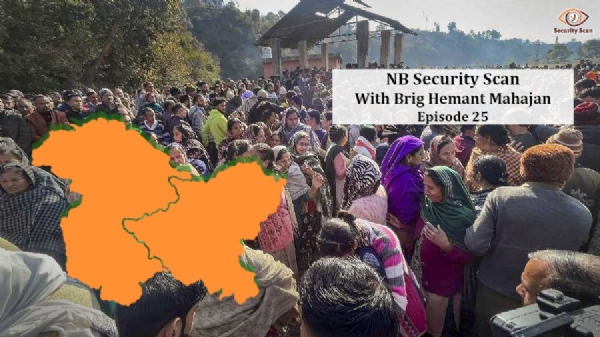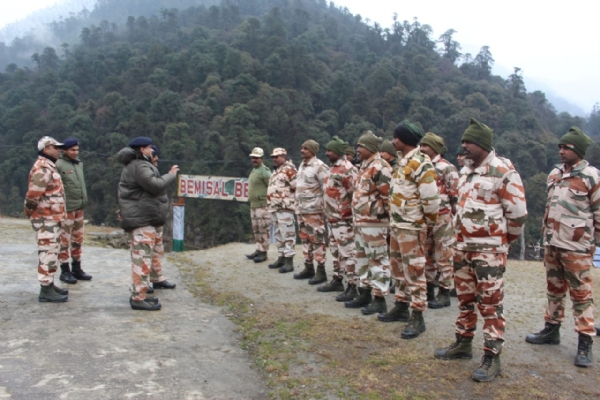#SecurityScan 25: Partnership of General Atomics with Bharat Forge, recent killings in Kashmir and more
Amit Shah asked the Border Security Force to effectively use the Vibrant Village Programme (VVP), announced by the Centre in the 2022 Budget, to promote development and communication in border villages.
Total Views |
This article is a summary of important events that have taken place in last one week affecting, India's national security.

NEWS IN BRIEF
The Taliban-led administration in Afghanistan signed its first international contract Thursday to extract oil from the northern Amu Darya basin to increase revenue. The agreement with China’s Xinjiang Central Asia Petroleum and Gas Co. was inked in Kabul in the presence of Chinese Ambassador to Afghanistan, Wang Yu, and the Taliban’s Deputy Prime Minister for Economic Affairs.
India has taken a step toward allowing leading foreign universities such as Yale, Oxford and Stanford to set up campuses and award degrees as part of an overhaul of the higher education.
Regulator the University Grants Commission on Thursday unveiled a draft legislation to facilitate entry and operation of overseas institutions in the country for the first time. The local campus can decide on admission criteria for domestic and foreign students, fee structure and scholarship. The institutions will have the autonomy to recruit faculty and staff.
Russian forces are repeating basic errors that are compromising the security and safety of their own soldiers in occupied Ukraine, including failing to shut down cellphone use in areas where troops are concentrated within range of Ukrainian artillery.
In the latest example that suggests poor Russian operational security, Ukrainian forces destroyed a facility used as a base for mobilized troops in the city of Makiivka, in the Donbas area of eastern Ukraine causing very heavy casualties to Russian troops.
INTERNAL SECURITY
General Atomics partners with Bharat Forge to manufacture aero structures in India
It will also help India develop a manufacturing ecosystem for high-end drones. The move will provide India with an opportunity to manufacture main landing gear components, subassemblies, and assemblies of remotely piloted aircraft in the country.
Ukraine military says killed 800 Russian soldiers in past one day.
Killing in Kashmir
The new year has started on a tragic note for Jammu and Kashmir. Four civilians were killed when terrorists fired at three houses of members of a community at Dhangri village in Rajouri on Sunday evening. The next day, two children were killed in an IED explosion near the house of a victim of the Dhangri attack. The two incidents, come on the heels of External Affairs Minister S Jaishankar’s statement that terrorism cannot be used as a tool to force India to the negotiating table.
It is quite clear that despite being affected by terrorism itself, Pakistan will continues to aid and abet terrorism in pursuance of its old policy of ‘bleeding India with a thousand cuts.’
Amid attacks on civilians, Centre to deploy 18 additional CRPF companies in Jammu and Kashmir.
Development of Border Area Villages
The Government of India is paying special attention to the development of border villages, especially from a security perspective. Union Home Minister Amit Shah said that borders could be permanently secured only when border villages are populated by patriotic citizens who are concerned for the country. He asked the Border Security Force to effectively use the Vibrant Village Programme (VVP), announced by the Centre in the 2022 Budget, to promote development and communication in border villages. The government has said VVP would cover construction of village infrastructure, housing, tourist centres, road connectivity, provisioning of decentralised renewable energy, direct-to-home access for Doordarshan and educational channels, and support for livelihood generation.
There were also plans to open the villages along the China border in Himachal Pradesh, Uttarakhand, Sikkim, Arunachal Pradesh and the Union Territory of Ladakh for tourists. The MHA recently informed a Parliamentary Standing Committee that the budget provisions for the programme have been sent to the Expenditure Finance Committee for its approval.
Energy Security National Green Hydrogen mission
The Union Cabinet has cleared a National Green Hydrogen (NGH) mission that aims to facilitate the production of hydrogen from renewable energy. By 2030, the goal is to have at least 5 million metric tonnes of annual green hydrogen production, electrolyser capacity of 60-100 gigawatt and a 125-gigawatt renewable energy capacity for green hydrogen and its associated transmission network.
With an initial outlay of Rs 19,744 crore, the Centre has earmarked Rs 17,490 crore for the Strategic Interventions for Green Hydrogen Transition Programme (SIGHT) programme with Rs 1,466 crore for pilot projects, Rs 400 crore for R&D, and Rs 388 crore for other components of the mission.It is expected that the project will attract investments of Rs 8 lakh crore and create over 6 lakh jobs by 2030.
The benefits envisaged include export opportunities, decarbonisation of sectors like mobility, industries and energy, reducing dependence on imported feedstock and fossil fuels, indigenous manufacturing ability enhancement, job creation, R&D for cutting-edge tech. The mission aims to help in creation of demand, production, export and utilisation of green hydrogen.

Green hydrogen, currently accounts for less than 1% of global hydrogen production and India’s aim is to become a global, industrial hub and exporter of such hydrogen. The Central government’s decision to launch the National Green Hydrogen Mission, with the objective of making India a global hub for green hydrogen, and its derivatives, and take the lead in its production, utilisation and exports, is one of India’s first attempts to be on an early curve of a new revolution.
India must also urgently add research and development to its armoury so that the highest value creation in this nascent energy sub-segment, with its potential for green and clean energy, is created in our country. Hydrogen, with its limitless and extremely low cost supply, can become a powerhouse for India’s next generation transformation, and for the first time in our history, we are not going to be missing the bus but being a pioneer instead.
Anti Piracy Law
In December 2022, both Houses of Parliament finally passed a special legislation on “repression of piracy”. The 2019 Anti-Maritime Piracy Bill is in tune with India’s assurance of “respect for international law” and “commitment to international law”. The Standing Committee on External Affairs (SCEA) has provided concrete suggestions to strengthen the original Bill, which was introduced in Parliament by the External Affairs Minister on December 2, 2019.
It seeks to address the challenge of piracy on the high seas and gives effect to obligations under the 1982 UN Convention on the Law of the Sea (UNCLOS). The UNCLOS, with 168 parties, was ratified by India on June 29, 1995.
Job Security and Defence Budget
That the unemployment rate in India surged to 8.3% in December 2022, the highest in 16 months, should be a cause for concern for all. While India remains one of the fastest-growing economies in the world, the fact remains that jobs have not been created at a steady pace and exports have fallen.
The country’s current account deficit reached an all-time high of $36.4 billion in the July-September quarter, the trade deficit with China has risen to record levels, and the rupee had a terrible year, falling from Rs 74.33 to Rs 82.72 to the US dollar in 2022. All this, along with the IMF warning, suggests that we are in for another difficult year. As per an earlier IMF assessment, global growth was forecast to slow down from 6 per cent in 2021 to 3.2 per cent in 2022 and 2.7 per cent in 2023. This is deemed to be the weakest growth profile since 2001 and the IMF chief noted that the three major economies — the US, the EU and China — are all slowing down simultaneously. While India has managed the economic slowdown better than most of the major economies, the overall drop in global growth will impact India’s export potential with attendant fiscal challenges — particularly in relation to fund allocation for the Defence Budget.
Women Security- Making India safer for women
In last one week the media has reported many sensational crimes against women. How do we make India safe for women?
National Crime Records Bureau data shows that in 2021, a crime against a woman was recorded nearly every minute, with abduction, rape and domestic violence forming the bulk of the cases. These numbers have risen year after year, indicating both institutional inability to tackle violence against women and more robust reporting of these crimes as a result of greater awareness.
Making women from all communities, castes, regions and backgrounds safer in our cities and villages must be a national goal achieved through broader and deeper solutions.
Sensationalism cannot effectively tackle crimes against women at a larger level, only even-handed, reliable and persistent law enforcement can, because it tells criminals that they cannot get away.
India deploys platoon of women peacekeepers in UN mission in Abyei

This will be India's largest single unit of women Peacekeepers in a UN Mission since we deployed the first-ever all-women's contingent in Liberia in 2007.
It will also herald India's intent of increasing significantly the number of Indian women in Peacekeeping contingents.
EXTERNAL SECURITY
Is Pakistan planning to eliminate Tehrik-e-Taliban terrorists in Afghanistan with American help?
Pak Army chief travels to Saudi Arabia on his maiden visit abroad. According to a report in South China Morning Post (SCMP), Pakistan is likely to launch a major ground as well as air offensive to target the hideouts of Pakistan Taliban militants in Afghanistan, risking further deterioration of ties with it.
Lessons From Yangtse-Gen V P Malik
This is an extract of article written by General VP Malik former chief of Army staff.
The Rules Of Engagement (ROE)-Soldiers Allowed To Fire
China has repeatedly flouted all five agreements on LAC/border issues, signed with India since 1993. There is neither peace nor tranquillity for the soldiers posted on the LAC. Why, then, is the Indian army being made to follow the ROE which were drawn as a follow up of these broken agreements? It is wrong to expect the army, any army, to get involved in physical melees, brawls and scuffles with its adversary. No army is expected to fight with crude sticks. Even on sentry duty, a soldier is expected to stop any stranger at a distance. If that person continues to advance, the soldier on duty is expected to fire for effect. It is high time that we follow the same norms on the LAC. Our soldiers should be allowed to fire if, despite warning, the adversary continues to advance toward our position.
LAC Perceptions: need to be straightforward
Why do we continue to use terms like “our” and “their” perceptions of the LAC? When the government of India has given maps on which the LAC is marked and expects the military to ensure that no territory is lost, such little known perceptions of the LAC invariably cause a fiasco while explaining the situation in Parliament and to the public. The Chinese do not use the terminology of perception in their statements. In fact, it gives them a handle to continue with their aggression activities as happened post Galwan. In the geographically transparent environment which prevails today, we must give out our version of the LAC subject to a final resolution of the boundary dispute with China. We need to be straightforward and remain firm on the ground.
Intelligence And Surveillance Along The Northern Border Requires Urgent Focus
Intelligence is a nation’s first line of defence. This, with our surveillance structure, is a critical constituent of safety, security and also grand strategy. In the kind of terrain where the military is operating, it is almost impossible to defend “every inch of territory”. We need reliable and timely information to mobilise adequate forces where the adversary is expected to strike or intrude. It requires a round-the-clock, high level of intelligence, all-weather surveillance capabilities and assessments for the troops on the ground. In 2020, despite satellite imagery, high altitude UAVs and availability of a host of modern surveillance equipment, we failed to assess and react to the Chinese troops’ movements in Eastern Ladakh.
Our intelligence and surveillance structure along the northern border requires urgent focus and improvement wherever gaps exist.
Dual Command And Control: Leads To A Lack Of Coordination

The Western and Central sectors of the LAC are guarded by the Indo-Tibetan Border Patrol (ITBP) backed by the army. However, both work under different ministries. Despite several discussions, there is no unified command and control, which often leads to a lack of coordination, responsibility and accountability.
The ITBP units deployed on the LAC, now hot, need to be placed under the operational control of the army.
Offensive Spirit: Retaliate Proactively Like Kailash Range Ops
During training, we diligently inculcate and imbibe an offensive spirit in our military. And yet, most of the time, we expect the military to remain defensive and passive on the border.
Our frontline military formations should not only be capable of defending intrusions but also plan and be prepared to retaliate proactively — Kailash Range style — taking advantage of the high altitude mountainous terrain.
General VP Malik hits the nail on the head and his assessment must be seen by all policymakers.
Upgrading airfield In Ladakh- India to match China’s infra buildup
The prolonged standoff in Ladakh has witnessed major buildup of infrastructure along the Line of Actual Control (LAC) in the form of bridges, roads and airfields; the obvious objective is to enable quick movement of troops and equipment, overcoming the constraints posed by the difficult terrain.
The Ministry of Defence has decided to upgrade the Nyoma airfield in eastern Ladakh into a full-fledged fighter jet base with allied infrastructure. The upgrade is estimated to cost Rs 214 crore and will be completed in a couple of years. The presence of Chinese airfields along the LAC gives India a good reason to augment its operational preparedness.
The approval granted to the Rangrik airfield, which will come up in Himachal Pradesh’s Spiti valley, near Chepzi (Tibet), is also in line with the strategy to ensure smoother conduct of air force activities.
Providing adequate equipment and infrastructure to the IAF will help them perform surveillance and reconnaissance exercises more efficiently.
However strategically significant Sela tunnel project in Arunachal has been delayed. It is now expected to be completed by April. Such delay can impede India’s efforts to keep the Chinese on their toes.
Upgrading India’s Counter intelligence

The deaths of a Russian businessman-politician – who was a known critic of Putin – and his friend in Odisha under mysterious circumstances should alert India’s intelligence and security apparatus. As of now, the politician’s death is being termed accidental, although the fact that the local police didn’t preserve the viscera after post-mortem, as is the SOP, has raised many questions. Let’s note that the chairman of Russia’s second largest oil company fell to his death from a hospital window in Moscow. He too had called for an end to Russia’s military operation.
Suspicious deaths are of course as old as international intrigue and conflict. Various intelligence agencies occasionally target individuals in other countries is known. India must raise the cost of such operations by foreign agencies through superior counterintelligence. As India’s strategic profile increases from the Ukraine conflict to the Taiwan Strait tensions – there is a danger of foreign agents bringing their battles to this country.
China has been setting up secret police stations in other countries to coerce or intimidate Chinese nationals there. This especially should deeply worry India. More than 100 such overseas Chinese police stations have been established in countries such as the Netherlands, Ireland, South Korea, Japan, Germany and the US among others. The same modus operandi could be used by Beijing in India too, not just to monitor Chinese nationals here but to also execute plans that may have bigger security implications for New Delhi.
Given newer challenges, India’s counter intelligence should be upgraded. So far, India’s security apparatus has been largely geared towards fighting and preventing terrorism. But we may have to increasingly deal with far more sophisticated threats. Well-resourced, highly trained professionals are part of becoming a major power.
Drone Advances In Ukraine Could Bring Dawn Of Killer Robots
The drawn-out conflict has accelerated a trend towards autonomous fighting machines that will select and attack targets without human aid.It may be only a matter of time before either Russia or Ukraine – or both – deploy weapons that kill entirely on their own.
Ex-General Electric employee sentenced to 2 years for conspiring to steal trade secrets for China.New York-based engineer who specialised in turbine sealing technology worked at company for 10 years.Sentencing follows conviction alongside Chinese businessman over plan to take proprietary knowledge.
---


